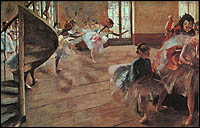Edgar Degas (1834-1917)

Full Name: Hilaire Germain Edgar Degas
Country: France
Style: Impressionist, or something like it
Teachers: Louis Lamothe (@ the Ecole des Beaux-Arts)
Major Works:
- Viscount Lepic & His Daughters (1873)
- Ballet Rehearsal - Adagio (1876)
- The Glass of Absinthe (1876)
- Two Laundresses (1882)
- The Tub (1886)
Interesting Stuff: Degas is best known for bringing us images of bodies in motion. They may be horses, they might be bathers or laundresses or (most famously) ballet dancers, but all of them have been frozen in a moment of movement and exertion.
A fan of photography and Japanese prints, his off-center empty spaces and arrangement of figures tends to draw you into the paintings as if you were an unseen spectator to the scene. After seeing painting after painting of young ballet dancers, Degas' work starts to seem downright yoyeuristic - and I'm not talking about reading the newspaper over somebody's shoulder voyeurism. I'm talking about disturbing voyeurism, like that uncle nobody likes who stares down your girlfriend's shirt at Thanksgiving, or the scary old guy in the park watching kids.
However, as intimate as these scenes are, we have to remember that these aren't photos. Degas didn't pull out his easel and hurredly paint these fleeting moments like some sort of demented federal express watercolor artist. Often, he would do quick sketches of scenes, and then return to his apartment to arrange them and finally paint the scene. This is what confuses me about calling him an Impressionist. On the one hand, he's trying to capture the fleeting impression of movement. On the other, he's systematically arranging images and creating things from his memory -- not directly from the impression.
The best story I've heard about Degas alleges that he once painted a portrait of Manet and his wife. As the story goes, in the painting Manet was on one side listening to his wife play the piano. Manet hated the portrait of his wife so much that he cut that end off the painting! Word somehow got back to Degas, and needless to say, he was quite steamed - and returned to the Manet household and took the remains of the painting back!